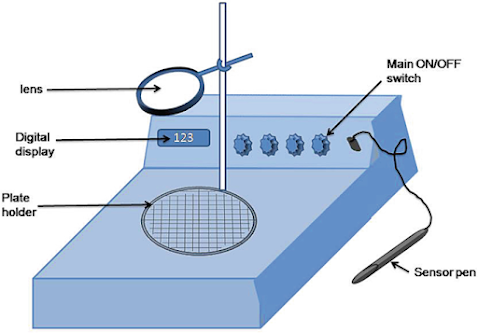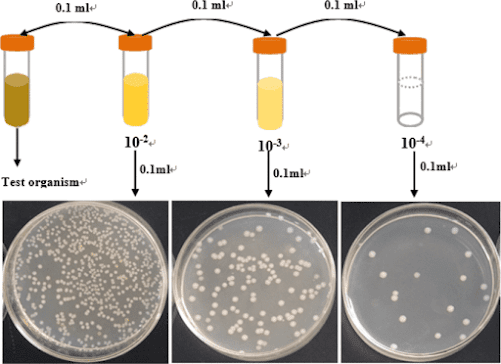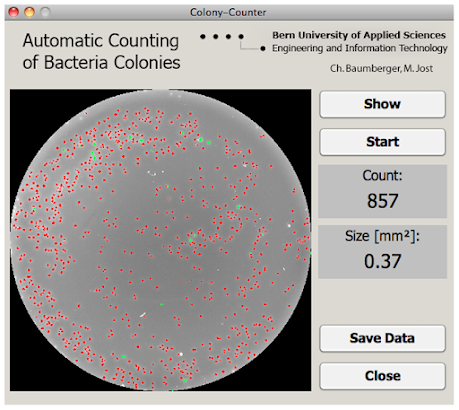Colony Counter - Principle, Types, Parts, Application
The colony counter is an instrument that is commonly used to
count colonies of bacteria or other microorganisms on a plate containing a
gelled growth medium. A fully automated system would essentially consist of
collecting images using any one of the digital image capturing devices such as
document scanner/charge coupled device digital camera/webcam or video
equipment. Colonies can be counted from pictures of plates using software
tools. In automated systems, the objects and their backgrounds can be varied
widely. Usually, one of the three methods of illumination can be selected to
enhance visibility and increase accuracy. These are the following: transmission
method, reflection method, and dark field method. The colony counter is used
for microbiology applications for fast and accurate counting of bacterial and
mould colonies.
A colony counter is a device that is frequently used to count bacterial or other microorganism colonies on a plate that contains a gelled growth medium.
Microbiologists have to tackle the daunting task of counting colonies, which can occasionally be undersized and obscured by the unique color of the culture media or the enumeration process itself. Thus, everyday routines require a better and more effective method of optimizing procedures.
A colony forming unit or CFU is a precise measurement to determine how many bacterial or mycelial cells are present in a given sample. Thus, the colony counting approach monitors viable CFUs, which can still reproduce via a process like binary fission under carefully monitored settings.
Purpose of colony counting
To determine the approximate number of cells in a sample
based on the cell’s propensity to continue growing and expanding in the
presence of specific factors, such as temperature and the quality of the
nutritional medium. Ideally, a single viable cell can undergo massive
replication to develop into a fully developed colony, given the correct
conditions.
Issues with colony counting
The following concerns must be addressed when attempting to
count all bacterial colonies that are present in a sample or filter:
- The number of colonies that do not overlap.
- The number of colonies that overlap.
- The number of colonies that contact the edges.
- To reduce the count because of noise.
- Colonies of various sizes, shapes, and colors.
- The aggregate of those mentioned above five will be the final count.
Importance of Colony counting
- Different businesses, including those in the food and beverage industries, employ the colony counting approach. Some of the importance include:
- Determining the colony counts helps to make ensure that the discharge of products won’t eventually cause any harm.
- Professionals may be more informed about any health issues a patient may be experiencing if they have more information about the concentration of microorganisms in their blood. One can determine the progression of a contagious disease, or even the efficacy of the individual’s immune system can be monitored.
Types of Colony counters
There are many types of colony counters. Some of these colony counters are manual, while others are automated. Whether manual counting or automatic counting, triphenyl tetrazolium chloride (TTC) was incorporated to make the colonies more apparent. Live bacteria convert TTC to a deep red colored product such that the colorized bacterial colonies are bright compared to the background.
Manual colony counters
Manual and semi-automatic counters rely on a technician’s
ability to distinguish between colonies and mark them on the plate’s outside
using a specific pen. The device maintains track of colonies with such
markings. Although this approach somewhat aids, it is nonetheless
time-consuming, chaotic, and prone to mistakes.
Parts and their functions of manual colony counters
- Auto marker probe pen: A counter pen’s pressure on a colony causes a count to be registered by an audible beep and an advance on a computer screen.
- Digital display: It reflects the total count made by the counter pen.
- Lens: It helps in magnification.
- Light source: A backlight source is used for illumination purposes.
Working Principle of Manual colony counters
A Petri plate is placed on an electronic pressure pad with
light illumination, and each colony on the plate is marked by tapping the plate
with an auto marker probe pen. A count is registered in the digital display by
the touch’s pressure. This pressure can be altered based on the situation. It
facilitates avoiding the error of overlooking or counting colonies twice. The
equipment also has a graticule for Wolfheugal, a segmentation disc, and
centering adapters for 50-90mm plates. Additionally, added features include
darkening background for transparent colonies, glare-free illumination that
allows for optimal peripheral colony viewing, and an integrated averaging tool
for multiple plate counting.
Limitations of Manual colony counters
- Labour intensive
- Time-consuming
- Relative low throughput
- High risk of human error
Automatic colony counters
To effectively count colonies, the autonomous bacterial
colony counter employs image processing methods, including gray scaling,
thresholding, filtering, etc.
Parts and their Functions of automatic colony counter
- Culture dish: For a range of culture dishes, including the conventional plate inoculation method, the spiral inoculation method, etc., the automated colony counter is appropriate.
- Light source: A durable LED light source serves as the automated colony counter’s light source. There are four different light sources and background color combinations in it. Optional intelligent remote control multi-color light source background improving the accuracy of the count of various media color and type combinations.
- Imaging: The conventional artificial colony counter uses a 3–6 magnification lens for imaging.
- Image processing: The automated colony counting has a robust picture processing feature. Background processing, color marking, interference correction, colony expansion, area calculation, and other elements not seen in conventional colony counts are provided in the associated software.
- Database: Automatic colony counters improve data storage, intelligent query, data export, etc., with database processing compared to traditional colony counters. Some can also configure operator permissions, data modification permissions, etc., to make the measured data safer. Additionally, you may print and edit reports online simultaneously.
Principle of Automatic colony counters
A computer-based system is fundamentally composed of the
collection of images utilizing any of the digital image-capturing devices such
as document scanners, charge-coupled devices (CCD), digital cameras, webcams,
or video equipment. Colonies can be enumerated from images of plates through
the use of software tools. Every plate is photographed and then analyzed. The
recorded photos are then converted to digital files on a computer using
programmable image-processing software. Single/multi-threshold segmentation
techniques are used to separate and identify any colonies present. The
backgrounds of the objects and objects themselves can vary greatly in automated
systems. To improve visibility and boost precision, one of the three
illumination techniques can often be chosen. They are:
- Transmission technique: Applied to common, high contrast items with largely clear backgrounds.
- Reflection technique: Used for objects with high contrast and opaque backgrounds.
- Darkfield technique: For low-contrast, largely transparent objects.
Advantages of automatic colony counters
- Accurately count even the most difficult samples
- Work with any sample type, even samples with very little contrast
- Take on colonies of every size and form
- Take care of all noises.
- Even in extremely overlapping colonies, high curvature locations can be found.
- Click photographs of a Petri plate containing colonies in about 10 seconds, and the software can evaluate it immediately.
- The time needed for counting is reduced.
- Use of software decreases manual effort.
Application of colony counters
- Bacterial colony counting is used in microbiology labs to assess the filter or membrane’s capacity for retention.
- It is crucial for determining the efficacy of disinfectants, including for use in testing the safety of food and drugs, as well as medical examination assessments in medical facilities and the pharmaceutical industry.
- Measure the density of microorganisms in liquid culture by counting each colony on an agar plate, slide mini gel, or petri dish.
- Ame’s testing
- Bacterial mutation assays
Examples of Colony Counters
a. Colony counter JL Series (Manufacturer: Zhejiang FUXIA
Medical Technology Co., Ltd.)
Features
- It is a particular type of digital display semi-automatic bacteria examination tool.
- A counter, a probing pen, and a counting pool make up the device.
- CMOS integrated circuits are used in the design and production of the counter.
- The bacterial colony contrast is visible in the counting pool with a black depth background when the energy-saving ring lamp is utilized for side lighting.
- The instrument display is made as a three-digit number following the bacterial count test protocol.
- The test sample must be diluted and repeated when the number of bacterial colonies in a petri dish surpasses 999 to confirm the count’s accuracy.
b. Colony counter QUANTOM TxTM (Manufacturer: Logos
Biosystems)
Features
- The QUANTOM TxTM scans up to 10 fields of view and generates precise single bacterial cell counts.
- The sophisticated program can consider how various bacteria can have diverse sizes, shapes, and configurations.
- A computerized, image-based cell counter called the QUANTOM TxTM Microbial Cell Counter can quickly identify individual bacterial cells. Even the most compact clusters of bacteria may be counted using the company’s innovative bacteria-optimized cell detection software.
c. Colony counter LKB 2002 (Manufacturer: POL-EKO-APARATURA
sp.j.)
Features
- The LKB 2002 colony counter can automatically adjust for different Petri-plate weights.
- For plates with a diameter of less than 120 mm, adapters are included.
- The colony counter has an adjustable pressure force, a magnifying glass, and shock-resistant counting technology.
- You can work against a light or dark background because the ring light illuminates the counting field.
- Numerous helpful features, including overall mean value calculation and acoustic/visual counting control, are included with the LKB 2002 colony counter.
d. Colony counter Scan® 400 (Manufacturer: Interscience)
Features
- The Scan 400 is an automatic colony counter with all the necessary components for counting Petri dishes. It is tailored to the common media in food microbiology, including PCA and MRS.
- Languages: English, French, Japanese, Chinese, Russian, Spanish, and German
- Minimum size of the detected colony: 0.1 mm
- Camera: 1 megapixel – magnification x 28
- Counting on round Petri dishes of approximately 55 to 90 mm
References
Gupta, S., Kamboj, P., & Kaushik, S. (2012). Methodology
for Automatic Bacterial Colony Counter.
Khandpur, R.S. (2020). Compendium of Biomedical
Instrumentation || Colony Counter, Automated., 491–494.
doi:10.1002/9781119288190.ch95
https://www.elexbio.com/five-functions-of-automatic-colony-counter.html




















No comments